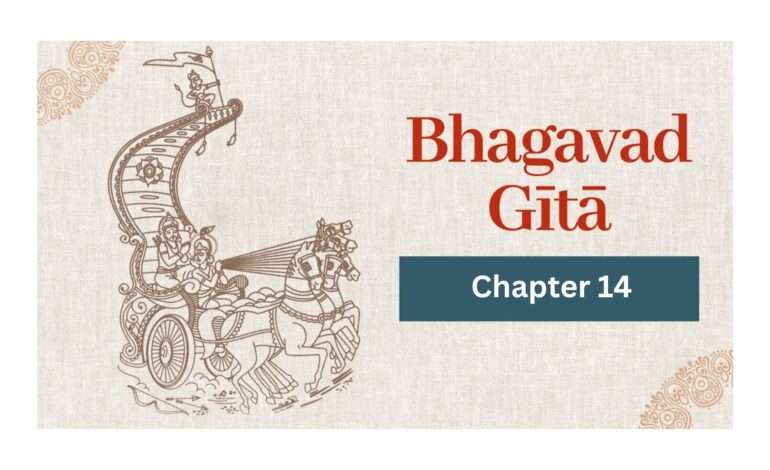
Gita study – in my understanding, chapter 14
By: Rajendra Kapil
Now we have reached the fourteenth step of this Gita series. This chapter gives us a detailed understanding of the qualities (gunas) and natural tendencies present in human life. Some people among us are of highly sattvic (pure and virtuous) nature. Some are entangled in worldly matters, surrounded by greed and other weaknesses — such individuals are called rajasik. The remaining ones live in ignorance and delusion; they are categorized as tamasik.
Shri Bhagavan Uvacha
Param bhūyah pravakṣyāmi jñānānām jñānam uttamam
Yaj jñātvā munayah sarve parām siddhim ito gatāḥ ॥ (1)
This chapter begins with a divine declaration by Lord Krishna. He tells Arjuna that the knowledge He is about to impart is extremely mysterious and sacred. By realizing this knowledge, many saints and sages have attained liberation from this world. This wisdom is expressed in the following verses:
Mama yonir mahad brahma tasmin garbham dadhāmyaham
Sambhavah sarva bhūtānām tato bhavati Bhārata ॥ (3)
Sarva yonishu Kaunteya mūrtayah sambhavanti yāḥ
Tāsām brahma mahad yonir aham bīja-pradah pitā ॥ (4)
Meaning:
O descendant of Bharata! My eightfold material nature — earth, water, fire, air, ether, mind, intellect, and ego — is the womb that gives birth to all beings. And I, as the Supreme Consciousness, place the seed of life within it. Through the union of matter and spirit, all living beings — moving and non-moving — are born. O son of Kunti! Whatever forms are born in all species, material nature is their mother, and I am the father who places the seed of consciousness within them.
These verses mean that both I and My divine nature (Maya) are the creators of this world. This nature sustains the universe like a womb that holds creation within itself, and I, as the divine father, plant the seed of life in it. Thus, the union of the conscious and unconscious gives birth to all beings on this earth.
Among these beings, there are three types of natural qualities (gunas):
- Sattva guna (the quality of purity)
- Rajas guna (the quality of activity and desire)
- Tamas guna (the quality of darkness and inertia)
Based on these qualities, the nature of every being is formed. The dominant quality shapes the person’s personality and actions. Let us understand what these qualities mean.
Sattvam rajas tama iti gunāḥ prakriti-sambhavāḥ
Nibadhnanti mahā-bāho dehe dehinam avyayam ॥ (5)
Tatra sattvam nirmalatvāt prakāśakam anāmayam
Sukha-sangen badhnāti jñāna-sangen cha anagha ॥ (6)
The First — Sattva Guna
This makes a seeker pure and peaceful by nature. It awakens the thirst for knowledge, compassion, and selfless service. One who has sattva guna naturally helps others and stays engaged in remembrance of God, continuously striving for spiritual growth. This quality leads a yogi toward the path of self-realization and divine wisdom.
The Second — Rajas Guna
This quality makes a person active and restless, absorbed in worldly pursuits. Such a person gives excessive importance to material gains and desires profit in every action. Profit leads to greed, and greed fuels endless longing for worldly pleasures. These attachments bind the soul in the cycle of action and result, making one forget God and mistake the material world as the ultimate truth. For such people, Lord Krishna said in the second chapter:
Karmanyevadhikāraste mā phaleshu kadāchana
Mā karma-phala-hetur bhūr mā te sangostv akarmaṇi ॥ (47)
O seeker, you have the right to perform your duties but not to the fruits thereof. Yet, the rajasik mind clings to results and strives endlessly to achieve them, often losing spiritual focus in the process.
The Third — Tamas Guna
The word tamas means darkness. This quality leads to ignorance, laziness, and delusion. People dominated by this quality avoid knowledge and prefer to stay ignorant. They are often pessimistic, filled with arrogance — of wealth, status, or strength — and remain surrounded by flatterers. The five vices — lust, anger, greed, attachment, and ego — dominate their behavior. Because tamas is a base quality, such people are narrow-minded and resistant to growth or learning.
Kair lingais trīn gunān etān atīto bhavati prabho
Kim āchāraḥ katham chaitān trīn gunān ativartate ॥ (21)
Hearing all this, Arjuna raises a question —
“O Lord, is there a devotee or yogi who rises above these three gunas? If so, what are his characteristics, and how does he transcend them?”
In response, Lord Krishna explains that a yogi who remains untouched by these qualities, who neither craves happiness nor despairs in sorrow, and who surrenders himself completely to the Divine, is considered to have transcended the gunas.
The characteristics of such a realized soul are beautifully described in the following verses:
Samaduhkha-sukhah swasthah samalostāshma-kānchanah
Tulya-priyā-priyo dhīras tulya-nindātma-samstutih ॥ (24)
Mānāpamānayostulyas tulyo mitrāri-pakṣayoh
Sarvārambha-parityāgi gunātītah sa uchyate ॥ (25)
Meaning:
He who remains balanced in pleasure and pain, who stays centered in his true Self, who views clay, stone, and gold alike, who is unmoved by praise or criticism, who treats honor and dishonor equally, who regards friend and foe with the same mind, and who has renounced all sense of doership — such a person is said to have transcended the qualities of nature.
Thus, through Arjuna, Lord Krishna teaches humanity to understand these three gunas, their good and bad effects, and the need to rise above them. By recognizing the faults hidden within these gunas, we can free ourselves from their bondage. This knowledge is a clear and direct path toward divine realization.
Let us all strive to absorb this rare and sacred wisdom and walk steadfastly on the path of attaining the Lord.
“Jai Shri Krishna!”